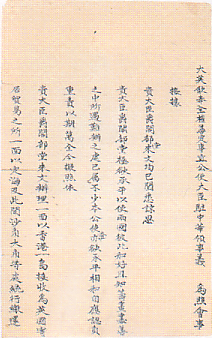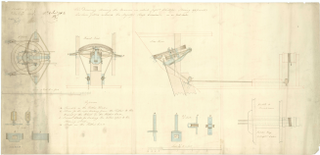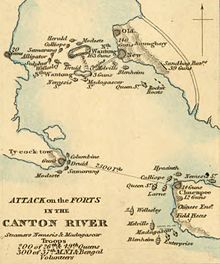
The First Opium War, also known as the Opium War or the Anglo-Sino War was a series of military engagements fought between the British Empire and the Qing dynasty of China between 1839 and 1842. The immediate issue was the Chinese enforcement of their ban on the opium trade by seizing private opium stocks from merchants at Canton and threatening to impose the death penalty for future offenders. Despite the opium ban, the British government supported the merchants' demand for compensation for seized goods, and insisted on the principles of free trade and equal diplomatic recognition with China. Opium was Britain's single most profitable commodity trade of the 19th century. After months of tensions between the two nations, the British navy launched an expedition in June 1840, which ultimately defeated the Chinese using technologically superior ships and weapons by August 1842. The British then imposed the Treaty of Nanking, which forced China to increase foreign trade, give compensation, and cede Hong Kong to the British. Consequently the opium trade continued in China. Twentieth-century nationalists considered 1839 the start of a century of humiliation, and many historians consider it the beginning of modern Chinese history.

HMS Rattlesnake was an Atholl-class 28-gun sixth-rate corvette of the Royal Navy launched in 1822. She made a historic voyage of discovery to the Cape York and Torres Strait areas of northern Australia.

The Convention of Chuenpi was a tentative agreement between British Plenipotentiary Charles Elliot and Chinese Imperial Commissioner Qishan during the First Opium War between the United Kingdom and the Qing dynasty of China. The terms were published on 20 January 1841, but both governments rejected them and dismissed Elliot and Qishan, respectively, from their positions. Foreign Secretary Lord Palmerston stated that Elliot acquired too little while the Daoguang Emperor believed Qishan conceded too much. Palmerston appointed Major-General Henry Pottinger to replace Elliot, while the emperor appointed Yang Fang to replace Qishan, along with Yishan as General-in-Chief of Repressing Rebellion and Longwen as an assistant regional commander. Although the convention was unratified, many of the terms were later included in the Treaty of Nanking (1842).

Admiral of the Fleet Sir William Parker, 1st Baronet, GCB, was a Royal Navy officer. As a captain's servant he took part in the Battle of The Glorious First of June in June 1794 during the French Revolutionary Wars and, as a captain, he participated in the capture of the French ships Marengo and Belle Poule at the action of 13 March 1806 during the Napoleonic Wars. He was detached on an independent command on the Tagus in September 1831 with a mission to protect British interests during the Portuguese Civil War. As Commander-in-chief of the East Indies and China Station, he provided naval support at various actions between 1841 and 1842 during the First Opium War. Appointed Commander-in-Chief, Mediterranean Fleet in February 1845, he was briefly First Naval Lord in the First Russell ministry from 13 July 1846 to 24 July 1846 but gave up the role due to ill health before returning to his command with the Mediterranean Fleet.

HMS Hyacinth was an 18-gun Royal Navy ship sloop. She was launched in 1829 and surveyed the north-eastern coast of Australia under Francis Price Blackwood during the mid-1830s. She took part in the First Opium War, destroying, with HMS Volage, 29 Chinese junks. She became a coal hulk at Portland in 1860 and was broken up in 1871.

Admiral of the Fleet Thomas Maitland, 11th Earl of Lauderdale, was a Royal Navy officer and peer. As a junior officer he saw action supporting the blockade of Algiers by Greek revolutionaries in July 1824 during the Greek War of Independence and then took part in an operation to land a naval brigade in Brazil to protect Pedro I, the Emperor of Brazil, in the face of the Irish and German Mercenary Soldiers' Revolt. He also took part in the Battle of Luchana, an operation to defend the Port of Bilbao on the north coast of Spain, during the First Carlist War.

HMS Wellesley was a 74-gun third rate, named after the Duke of Wellington, and launched in 1815. She captured Karachi for the British, and participated in the First Opium War, which resulted in Britain gaining control of Hong Kong. Thereafter she served primarily as a training ship before gaining the almost surely unwanted distinction of being the last British ship of the line to be sunk by enemy action and the only one to have been sunk by an air-raid.

The First Battle of Chuenpi was a naval engagement fought between British and Chinese ships at the entrance of the Humen strait (Bogue), Guangdong province, China, on 3 November 1839 during the First Opium War. The battle began when the British frigates HMS Hyacinth and HMS Volage opened fire on Chinese ships they perceived as being hostile.

The Second Battle of Chuenpi was fought between British and Chinese forces in the Pearl River Delta, Guangdong province, China, on 7 January 1841 during the First Opium War. The British launched an amphibious attack at the Humen strait (Bogue), capturing the forts on the islands of Chuenpi and Taikoktow. Subsequent negotiations between British Plenipotentiary Charles Elliot and Chinese Imperial Commissioner Qishan resulted in the Convention of Chuenpi on 20 January. As one of the terms of the agreement, Elliot announced the cession of Hong Kong Island to the British Empire, after which the British took formal possession of the island on 26 January.

The Battle of the Bogue was fought between British and Chinese forces in the Pearl River Delta, Guangdong province, China, on 23–26 February 1841 during the First Opium War. The British launched an amphibious attack at the Humen strait (Bogue), capturing the forts on the islands of Anunghoy and North Wangtong. This allowed the fleet to proceed further up the Pearl River towards the city of Canton (Guangzhou), which they captured the following month.

The Battle of the Barrier was fought between British and Chinese forces at the boundary separating Macao from the Chinese mainland on 19 August 1840 during the First Opium War. Located in modern-day Portas do Cerco, the Macao Peninsula was connected to Xiangshan Island by a narrow isthmus about 100 m (330 ft) wide and 1.2 km (0.75 mi) long. A wall called the Barrier was built across the isthmus in 1573, and it served as Macao's border.

The Battle of First Bar was fought between British and Chinese forces at First Bar Island and its surrounding area in the Pearl River, Guangdong province, China, on 27 February 1841 during the First Opium War.

The Battle of Whampoa was fought between British and Chinese forces at Whampoa Island on the Pearl River near the city of Canton (Guangzhou), Guangdong, China, on 2 March 1841 during the First Opium War.

The Battle of Amoy was fought between British and Qing forces at Amoy on Xiamen Island, Fujian, in the Qing Empire on 26 August 1841 during the First Opium War. The British captured the forts at Xiamen and on nearby Gulangyu Island.

Admiral Sir James Scott, KCB, was a British Royal Navy officer. He served in the Napoleonic Wars, the War of 1812, and the First Opium War.

The Broadway expedition was a British military expedition that explored the Broadway River in Guangdong province, China, on 13–15 March 1841 during the First Opium War. The river was also called the Inner Passage or Macao Passage as it served as an intricate channel from the Portuguese colony of Macao to the Chinese city of Canton (Guangzhou). The expedition was the first time a European vessel traversed the passage, and was believed by the Chinese to be inaccessible to foreigners due to the shallowness and intricacy of the channel as well as the forts along the banks. The iron steamship Nemesis had a shallow draught of 6 feet (1.8 m), which was a major advantage in navigating the river. Despite being over 600 tons burden, the ship was able to navigate through a river that frequently had less than 6 feet of water and through mud in areas of only 5 feet (1.5 m).

HMS Cruizer was a Snake-class ship-sloop launched in 1828 for the British Royal Navy. The ship was built as a revival of the retired Snake-class ship-sloops. The Navy converted her to a brig in 1831, back to a ship in 1840, and sold her at Bombay in 1849.

HMS Volage was a sixth-rate sailing frigate launched in 1825 for the Royal Navy. At one point geologist Thomas Abel Brimage Spratt served aboard her.
Royal Saxon was a British merchant ship built at Liverpool in 1829. She carried cargo and passengers to India, Australia, and the Far East. In 1839 Royal Saxon attempted to violate a Royal Navy blockade of Canton and inadvertently became the direct cause of the Battle of Chuenpi and consequently the First Opium War. She is last listed in Lloyd's Register in 1857.
Events from the year 1841 in China.




















